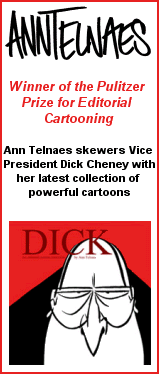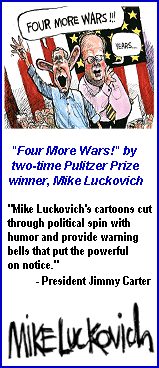Levin Reads Details of Bush Lies Into Senate Record
 Michigan Democrat Carl Levin took to the Senate floor on Friday and gave what amounted to a primer on the lies of the Bush administration leading to the Iraq war.
Michigan Democrat Carl Levin took to the Senate floor on Friday and gave what amounted to a primer on the lies of the Bush administration leading to the Iraq war."The President's decision to ignore intelligence community assessments prior to the Iraq war and to make repeated public statements that gave the misleading impression that Saddam Hussein's regime was connected to the terrorists who attacked us on 9/11 cost him any credibility he may have had on this issue," said Levin, who then went on to give a laundry list of some of the lies told by Team Bush.
Levin has provided some bullet points that are good ammunition for the next time some Republican sycophant tells you such charges against Bush are purely political, rather than proof positive of what a despicable administration this has been for six years now. He also cites the report issued by the Senate Intelligence Committee on Friday that sheds yet more light on attempts by Bush to mislead Americans on the justification for invading Iraq.
Here's Levin, for the record, on the Senate floor:
"President Bush said Saddam and Al Qaeda were allies--his words. And that:
'You can't distinguish between Al Qaeda and Saddam when you talk about the war on terror.'"The bipartisan report released today directly contradicts that linkage which the President has consistently made in his effort to build public support for his Iraq policy.
"The bipartisan committee report finds that the prewar intelligence assessments were right when the intelligence community said Saddam and Al Qaeda were independent actors who were far from being natural partners. The report finds that prewar intelligence assessments were right when they expressed consistent doubts that a meeting occurred between 9/11 hijacker Mohamed Atta and a senior Iraqi intelligence official in Prague prior to September 11. Our report finds that prewar intelligence assessments were right when they said there was no credible reporting on Al Qaeda operatives being trained in Iraq. Those were the two principal arguments which were used prior to the war to support the alleged linkage between Al Qaeda and Saddam Hussein.
"The accurate prewar intelligence assessments didn't stop the administration from making many false and misleading statements trying to link Saddam Hussein with Al Qaeda."
'In Iraq today harbors a deadly terrorist network headed by Abu Musab al-Zarqawi, an associate and collaborator of Osama bin Laden, and his Al Qaeda lieutenant.'"After the war, in June of 2004, the President said that al-Zarqawi, the terrorist leader recently killed in Iraq, was the best evidence of a connection between Iraq and Al Qaeda. And to this day--to this day--these statements have not stopped.
"Just 2 weeks ago, the President said in a press conference that Saddam Hussein 'had relations with Zarqawi.' Our Intelligence Committee report demonstrates that statement made 2 weeks ago by the President was false. The committee report discloses, for the first time, the CIA's October 2005 assessment that Saddam's regime:
'Did not have a relationship, harbor, or turn a blind eye towards Zarqawi and his associates.'"The President's statement made just 2 weeks ago is flat-out false.
"The drumbeat of misleading administration statements alleging Saddam's links to Al Qaeda was unrelenting in the lead-up to the Iraq war which began in March of 2003.
"On September 25, 2002, the President said:
'Al Qaeda hides. Saddam doesn't, but the danger is that they work in concert. The danger is that Al Qaeda becomes an extension of Saddam's madness and his hatred and his capacity to extend weapons of mass destruction around the world.'"And then he said:
'You can't distinguish between Al Qaeda and Saddam when you talk about the war on terror.'"The next day, in September of 2002, Secretary Rumsfeld said:
'We have what we consider to be credible evidence that Al Qaeda's leaders have sought contacts in Iraq who would help them acquire weapons of mass destruction capabilities.'"On October 14, 2002, the President said:
'This is a man Saddam is a man that we know has had connections with Al Qaeda. This is a man who, in my judgment, would like to use Al Qaeda as a forward army.'"On January 30, 2003, Vice President Cheney said:
'Saddam's regime aids and protects terrorists, including members of Al Qaeda. He could decide secretly to provide weapons of mass destruction to terrorists for use against us. And as the President said on Tuesday it would just take one vial, one canister, one crate to bring a day of horror to our Nation unlike any we have ever known.'
"On February 6, 2003, Deputy Secretary of Defense Wolfowitz said:
'And, worst of all, his connections with terrorists which go back decades and which started some 10 years ago with Al Qaeda are growing every day.'"What the administration and the President and other administration officials did not say was what the intelligence community was saying about this crucial issue because it would have undermined their march to war and it would have refuted their main argument for attacking Iraq: that Iraq was linked to the terrorists who attacked us on 9/11.
"What was the CIA saying? What was the intelligence community saying before the war? In June of 2002, the CIA said that:
'Our assessment of Al Qaeda's ties to Iraq rests on a body of fragmented, conflicting reporting from sources of varying reliability.'"That same report of the CIA said:
'The ties between Saddam and bin Laden appear much like those between rival intelligence services.'"And the Defense Intelligence Agency stated in a July 2002 assessment, being declassified for this first time in this report:
'Compelling evidence demonstrating direct cooperation between the government of Iraq and Al Qaeda has not been established.'"So these two then-classified assessments preceded the President's statements that 'You can't distinguish between Iraq and Al Qaeda' and that, in his view, Saddam would love to use Al Qaeda as a 'forward army.'"
"The CIA assessed in January of 2003 that Saddam viewed Al Qaeda with 'deep suspicion' and stated that:
'The relationship between Saddam and bin Laden appears to more closely resemble that of two independent actors trying to exploit each other.'"That 2003 classified report was issued 1 day before the Vice President stated to the American public that Saddam's regime:
'Aids and protects terrorists, including members of Al Qaeda.'"The misleading statements by administration officials didn't stop there. The Intelligence Committee report recounts the story of the alleged meeting between Mohamed Atta and the Iraqi intelligence officer in Prague. In the fall of 2001, the Czech intelligence service provided the CIA with reporting based on a single source who stated that Atta met with an Iraqi intelligence officer in Prague in April of 2001.
"On December 9, 2001, Vice President Cheney was asked about the report on Meet the Press. The Vice President said:
'It has been pretty well confirmed that he -- The 9/11 hijacker Mohamed Atta -- did go to Prague and he did meet with a senior official with the Iraqi intelligence service in Czechoslovakia last April, several months before the attack.'"On March 24, 2002, the Vice President told Meet the Press:
'We discovered, and it has since been public, the allegation that one of the lead hijackers, Mohammed Atta, had, in fact, met with Iraqi intelligence in Prague.'"But the Intelligence Committee report released today cites a June 2002 CIA paper that said:
'Reporting is contradictory on hijacker Mohammed Atta's alleged trip to Prague and meeting with an Iraqi intelligence officer and we have not verified his travels.'"The Intelligence Committee report released today declassifies, for the first time, a July 2002 Defense Intelligence Agency paper that said:
'Mohammed Atta reportedly was identified by an asset, not an officer, of a Czech service, only after Atta's picture was widely circulated in the media after the attacks, approximately five months after the alleged meeting occurred."And that:
'There is no photographic, immigration, or other documentary evidence indicating that Atta was in the Czech Republic during the time frame of the meeting.'"Two months later, in September 2002, the CIA published its assessment that 'evidence casts doubt' on the possibility that the meeting had occurred and that:
'The CIA and FBI have reviewed the reporting available so far and they are unable to confirm that Atta met al-Ani in Prague.'"None of those assessments stopped the Vice President from continuing to suggest that the report of the meeting was evidence that Saddam's regime was linked to the 9/11 attack.
"On January 14, 2004, a full year after the CIA expressed serious doubts about the meeting and the fact that not a shred of evidence had been found to support the claim of a meeting, the Vice President told the Rocky Mountain News that the Atta meeting was 'the one that possibly tied the two together to 9/11.'
"Six months later, on June 17, 2004, the Vice President was asked whether Iraq was involved in 9/11. The Vice President said:
'We don't know. ..... We had one report, this was the famous report on the Czech intelligence service, and we've never been able to confirm it or knock it down. We just don't know.'"The Vice President may not have 'known,' but the intelligence community sure as heck did not believe, and did not believe for a long time before the Vice President's statement, that the meeting took place."
Said Levin: "The intelligence assessments contained in the Intelligence Committee's unclassified report are an indictment of the administration's unrelenting and misleading attempts to link Saddam Hussein to 9/11. But portions of the report which the intelligence community leaders have determined to keep from public view provide some of the most damaging evidence of this administration's falsehoods and distortions."
Finally, the Michigan Democrat makes it clear that the parts of the report that remain classified are undisclosed based on decisions made by Republicans to protect the Bush White House.
"Among what remains classified, and therefore covered up, includes deeply disturbing information," said Levin. "Much of the information redacted from the public report does not jeopardize any intelligence source or method but serves effectively to cover up certain highly offensive activities."
"Even the partially released picture is plenty bleak, about the administration's use of falsehoods and distortions to build public support for the war. But the public is entitled to the full picture."

















<< Home